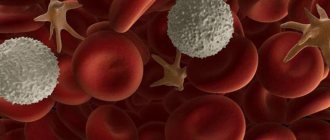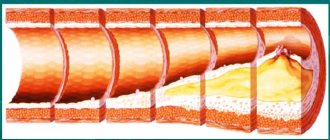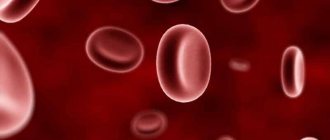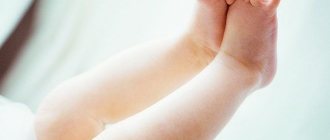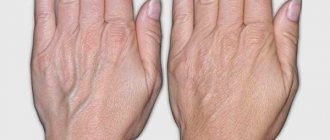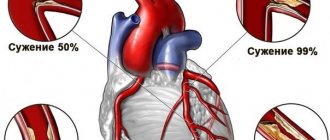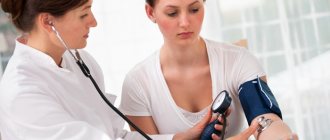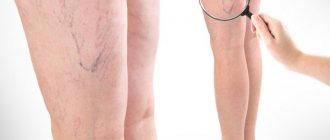Reticular varicose veins are a type of varicose veins, which is characterized by dilation of thin intradermal veins. In most cases, this disease affects women. Despite the fact that it is considered safe, the pathology has a pronounced cosmetic defect, and women strive to get rid of it as quickly as possible.
If you look at a photo of reticular varicose veins, you can see that the affected area on the leg is covered with a “mesh” of thin blue or purple venous vessels. That is why it is often called “cosmetic” varicose veins.
At CELT you can get advice from a phlebologist.
- Initial consultation – 2,700
- Repeated consultation – 1,800
Make an appointment
Causes of reticular varicose veins
Reticular varicose veins occur due to various reasons. One of them is taking hormonal medications, including during pregnancy. As hormones affect the small saphenous veins, they dilate and become noticeable. In addition, the causes of reticular varicose veins include prolonged static loads and excess weight. Most often, reticular varicose veins develop in patients with a genetic predisposition. It is not the pathology itself that is passed on to them from their parents, but the special structure of the blood vessels, which predisposes them to varicose veins. In pregnant women, this type of pathology occurs due to changes in hormonal levels and heavy loads on the lower extremities. As for other factors that stimulate the development of the disease, these include:
- long-term use of hormonal drugs;
- smoking;
- unbalanced diet;
- changes in hormonal levels in women;
- excess weight;
- the presence of venous-arterial fistulas;
- liver diseases;
- intense loads on the legs during sports training;
- work that requires frequent and prolonged standing.
Surgery
If the manifestations of reticular varicose veins are ignored for a long time, a person may experience serious complications. In this case, surgery will have to be performed. Only such a radical method will help stop the development of negative consequences.
The following activities are most often prescribed:
- Laser coagulation is a modern method of treating reticular varicose veins. This method of exposure can be used independently or as an addition to microscleropia. Special devices that produce a laser beam of a certain length affect the skin of the lower extremities. The entire event is carried out without anesthesia, since during the session the person does not experience any sensations. In this case, in one session it is possible to narrow the lumen of blood vessels by 1-3 millimeters.
- Microsclerotherapy is the most radical method of treating reticular varicose veins, in which a specialist completely excises the resulting vascular mesh. After the operation, you will have to wear compression garments for some time.
- Microphlebectomy – a special foam-forming substance is injected into the blood vessels, which prevents further growth of vascular networks.
Surgical treatment of reticular varicose veins does not promise complete relief from this pathology. Subsequently, if you follow the recommendations of your doctor, spider veins on the skin may appear again.
Clinical manifestations of reticular varicose veins
As a rule, the disease practically does not manifest itself, being a cosmetic defect. It appears in the form of a “mesh” of blue or purple venous vessels, which is clearly visible under the skin on the lateral surface of the thighs. The size of the lesion varies: from single vessels to very large formations raised above the skin. In addition, defects such as dilation of small veins in the legs may be clearly visible. Other symptoms are as follows:
- feeling of heaviness in the legs;
- swelling of the legs and feet;
- pain in the lower leg;
- the appearance of hemorrhages under the skin and external venous bleeding (in severe cases);
- cramps at night;
- local itching.
Symptoms of the disease
As mentioned earlier, reticular varicose veins are characterized mainly by external or visual manifestations. We are talking about vascular patterns appearing on the surface of the skin and a clearly visible vascular pattern. Venous networks appear on the legs of patients, individual veins are visible, and “spider veins” also form. It is also worth noting that visualization is caused precisely by the expansion of small veins; with the development of pathology, they reach a size of 1 to 3 millimeters in diameter.
However, reticular varicose veins are very different from varicose veins and we are talking not only about the difference in the damage to small and large, main vessels. Varicose veins lead to stagnation of blood, which is subsequently accompanied by the formation of more serious clinical signs, the appearance of trophic ulcers, hematomas, and an increased risk of blood clots and the development of thrombophlebitis.
As for the clinical signs of reticular varicose veins, they are very scarce. Patients do not complain of pain and other manifestations characteristic of varicose veins. The defect is purely aesthetic, with vascular networks most likely becoming visible in the areas of the calf muscles, under the knees, as well as on the back or inner thigh.
Treatment of reticular varicose veins
However, in rare cases, there are still patients who experience certain inconvenience and complain of the following unpleasant sensations:
- Increased leg fatigue.
- Feelings of heaviness and fullness at the end of the day.
- Minor swelling of the legs.
- Frequent attacks of cramps, which usually involve the calf muscle, and this happens at night.
- Somewhat more often, patients with reticular varicose veins are bothered by a feeling of itching in the area of vascular imaging.
Our doctors
Drozdov Sergey Alexandrovich
Cardiovascular surgeon, phlebologist, Doctor of Medical Sciences
Experience 46 years
Make an appointment
Malakhov Yuri Stanislavovich
Doctor - cardiovascular surgeon, phlebologist, Honored Doctor of the Russian Federation, Doctor of Medical Sciences, doctor of the highest category
35 years of experience
Make an appointment
Konstantinova Galina Dmitrievna
Cardiovascular surgeon, phlebologist, Doctor of Medical Sciences, Professor
Make an appointment
Treatment with medications
Treatment of reticular varicose veins of the lower extremities does not allow one to fully cope with the disease and is aimed at eliminating the clinical manifestations of the disease. It is carried out using medications, which also eliminate the risk of complications:
- Detralex tablets - eliminate pain and a feeling of heaviness in the legs;
- Antistax capsules - eliminate venous circulation disorders;
- Venoruton capsules - eliminate the risk of formation of retinal microthrombi, minimize the clinical manifestations of the disease;
- Phlebodia tablets - minimize symptoms;
- ointment "Troxevasin" - minimizes clinical manifestations, used only as prescribed by a doctor if indicated.
Traditional methods of treatment
Traditional medicine is increasingly becoming part of the everyday life of many people. For a long time now, patients have been abandoning synthetic drugs in favor of natural ingredients.
If you start treating reticular varicose veins in the initial stages, you will be guaranteed to get rid of this pathology. You can easily prepare an effective medicine even at home.
Means for the treatment of reticular varicose veins can be divided into two types: for external and internal use. To prepare effective drugs, it is not necessary to have any skills or knowledge. The only thing that is required of you is full compliance with the recipe and preparation rules.
The most popular traditional medicine recipes are:
- Take calamus root and grind it thoroughly in a coffee grinder. After this, take 20 grams of powder and pour 0.5 liters of red semi-dry wine. Leave the product for a week in a dark, cool place. After this time, take the tincture 30 minutes before meals for 2 months.
- Take birch buds and grind them into a fine powder. After this, pour 100 grams of the product with a bottle of vodka. Leave the resulting tincture for 10 days in a cool, dark place, and do not forget to stir the medicine every day. After this remedy, strain the tincture, and in the future use it for rubbing or compress.
- Take nutmeg and grind it to a powder. Take 1 teaspoon of this remedy every morning with plenty of plain water. With long-term use, your veins will become less noticeable, and you will also remove accumulated waste and toxins from the body.
- Take vervain and then grind it. Pour 2 teaspoons of this product with boiling water, then heat in a water bath. Pour the product into a convenient container, take a tablespoon 3 times a day with meals.
- Take the sweet clover and grind it. Pour 2 teaspoons of this plant into 500 milliliters of boiled water. Leave the product to infuse for 4 hours, then strain and take 50 ml before each meal. This therapy helps reduce pain, swelling, and makes veins less noticeable. The medicine also has a positive effect on the rate of blood clotting - it prevents the formation of blood clots.
Therapeutic treatment
Vein sclerotherapy
- Cost: 6,500 rub.
- Duration: 20-60 minutes
- Hospitalization: No hospitalization required
More details
The selection of therapeutic treatment methods is carried out individually, taking into account the results of diagnostic studies. The most effective are:
- Laser sclerotherapy is a painless procedure that allows you to successfully combat the disease in the initial and middle stages of development. Requires three procedures with an interval of one month;
- Foam sclerotherapy involves the introduction of sclerosing substances into the vessels that block it. It is carried out in the presence of medium and large veins, lasts from five minutes to one hour depending on the size of the lesion;
- Microphlebectomy provides a good cosmetic effect and allows you to return to your normal lifestyle immediately after the procedure. It involves puncturing a vein with a special hook, pulling it out and ligating it.
All of the above treatment methods require wearing stockings with a compression effect during the rehabilitation period. This approach allows you to minimize the load on the veins of the legs, stimulates venous outflow and eliminates blood stagnation. It is important that the patient wears compression stockings exactly as scheduled, as this will affect the results of treatment.
Signs on the legs
On the skin of the lower extremities there may be vascular changes in the form of lines that intersect and form a network. This pattern most often appears on the inner thighs. From the outside, small veins look like tree branches arranged in a circle. It is extremely rare that reticular varicose veins are accompanied by pain. In women, this phenomenon can occur during menstruation.
In the vast majority of cases, spider veins cause only a cosmetic defect.
The size of the zone of dilated vessels can vary from 0.5 mm to 5 - 10 centimeters. They have a dark red or purple hue. Such formations do not disappear spontaneously. In some patients, reticular varicose veins develop into varicose veins of the lower extremities with swelling, pain, and the formation of blood clots in the altered veins.
Prevention
Prevention of reticular varicose veins is as follows:
- maintaining an active healthy lifestyle;
- daily leg exercises;
- swimming.
For those at risk, the following should be added to the above:
- wearing compression stockings;
- avoidance of intense physical activity on the legs;
- balanced diet.
A few words about prevention and folk remedies
The hackneyed phrase “it is easier to prevent a disease than to treat it” forces in this case to put the prevention of a cosmetic defect in the first place, and then move on to treatment with folk remedies and pharmaceutical drugs, since it was still not possible to prevent it.
As for prevention, in relation to reticular varicose veins it is not only possible, but also necessary, especially if most close relatives are already affected by this defect. To prevent “snakes” of elongated and dilated capillaries from appearing on the skin, you need to:
prevention of varicose veinsBecome an adherent of proper nutrition, eradicating harmful food addictions;
- Forget about alcohol and cigarettes forever, strictly regulate the consumption of strong coffee;
- Do not ignore regularly wearing compression hosiery, but do gymnastics in the mornings or evenings (but every day) (there are special exercises for the prevention of reticular varicose veins - “scissors”, “bicycle”);
- It is advisable to sign up for a swimming pool and visit it regularly, but avoid baths and saunas;
- Avoid excessive physical activity.
Many admirers of alternative medicine continue to insist on treating any diseases with folk remedies, including the one described. Undoubtedly, from ointments, infusions, decoctions made at home, a certain benefit is not excluded, but it can only be in relation to the symptoms of the disease, if they occur (heaviness in the legs, swelling, cramps), but completely eliminate the cosmetic defect, Such a medicine cannot bring the vessels to their original (healthy) state.
example of exercises for the prevention of varicose veins
In principle, it is impossible to get rid of any varicose veins once and for all without the use of minimally invasive but physical interventions or major surgery (if there is no other way out), and conservative therapy is not at all intended to completely eliminate all problems. Both pharmaceutical and folk remedies are designed only to “calm” the veins, create comfortable conditions for them and, thus, reduce the manifestations of the pathological process.
As a treatment with folk remedies, tinctures of the fruits of horse chestnut, nettle, and Kalanchoe are used. Apple cider vinegar diluted with water in a ratio of 1:10 is popular among people - they rub it on their shins before going to bed. Some people make compresses from sour milk and note relief in their legs and the disappearance of pain.
Meanwhile, the reader will probably agree that with reticular varicose veins, diagnosed by a single sign (an intricate pattern on the skin of one of the lower extremities) and occurring without any other symptoms, hardly anyone would want to treat a cosmetic defect for a long time and persistently with folk or pharmacy remedies. Young women who are interested in the beauty of their own legs will most likely look for clinics that offer to get rid of the problem in one fell swoop, and older people will probably not attach any importance to the vascular network if the larger venous vessels remain unchanged and do not cause any problems. inconvenience. To each his own…
Our services in phlebology
The administration of CELT JSC regularly updates the price list posted on the clinic’s website. However, in order to avoid possible misunderstandings, we ask you to clarify the cost of services by phone: +7
| Service name | Price in rubles |
| Appointment with a surgical doctor (primary, for complex programs) | 2 700 |
| Appointment with a cardiovascular surgeon (phlebologist), MD. Malakhova Yu.S. with ultrasound examination (primary) | 4 500 |
| Duplex scanning of the veins of both lower extremities | 6 000 |
| Duplex scanning of the veins of one lower limb | 3 500 |
All services
Make an appointment through the application or by calling +7 +7 We work every day:
- Monday—Friday: 8.00—20.00
- Saturday: 8.00–18.00
- Sunday is a day off
The nearest metro and MCC stations to the clinic:
- Highway of Enthusiasts or Perovo
- Partisan
- Enthusiast Highway
Driving directions
FAQ
What are the ICD-10 codes for reticular varicose veins?
According to the International Classification of Diseases, 10th revision (ICD-10), the main code assigned to a disease such as varicose veins of the lower extremities is I83 . There are also clarifying codes that can be included in the diagnosis if necessary.
- Varicose veins of the legs with ulcer (I83.0).
- Varicose veins of the legs with inflammation (I83.1).
- Varicose veins of the legs with ulcers and inflammation (I83.2).
- Varicose veins of the legs without ulcer or inflammation (I83.9)
The last subcode (I83.9) includes phlebectasia of the legs, including without specified localization.
What visual photos of reticular varicose veins exist?
Reticular veins are most often confused with spider veins, or so-called spider veins. That is why it is useful to look at the photo to understand the difference.
The photo shows spider veins (purple and thin) as well as reticular veins (green and larger in diameter) with arrows.
Reticular varicose veins can occur on the thighs and legs, as can be seen in the photo above.
Sometimes reticular varicose veins develop in the ankle area, and then tissue swelling can occur quite quickly.
Is reticular varicose veins of the lower extremities dangerous?
At first glance, reticular varicose veins are not a dangerous disease, since often there are no subjective complaints when they appear. But according to doctors, the definition of reticular varicose veins may indicate hidden venous insufficiency. This disease is much more serious and is considered truly dangerous, so you should not ignore the first signs of reticular varicose veins.
Is natural childbirth possible with reticular varicose veins?
Reticular varicose veins are considered a reversible form of the disease, therefore, even with the upcoming birth and the absence of symptoms such as swelling of the legs, etc., you can quite successfully give birth to a healthy baby on your own.
The only thing is that even during pregnancy you may need to follow your doctor’s recommendations for conservative treatment of varicose veins, which will help you feel good after childbirth.
When should you see a doctor?
If self-help methods such as exercise, raising your legs while sitting and/or wearing compression stockings do not give the desired result and/or you want to purely cosmetically improve the condition of the venous vessels, you should make an appointment with a phlebologist to discuss the most appropriate treatment.
It is important to seek medical help immediately if you develop leg ulcers or other wounds that will not heal.
Reticular varicose veins: who cured it?
This question is often of interest to people who have just encountered their problem. In fact, varicose veins are most effectively treated in the early stages of development, when the vessels have just begun to appear and the symptoms are not yet very pronounced. In such cases, it is enough to be examined by a phlebologist and treated with prescribed medications to improve the condition.
Sometimes doctors recommend wearing compression stockings, but when using them you should remember important points:
- In the morning, before lowering your legs from bed, you need to do simple exercises for your legs, such as scissors and a bicycle.
- Your legs should be placed vertically, leaning them against the wall, and remain in this position for up to 10 minutes.
- Next, without lowering your legs, put on compression garments.
If, purely mechanically, the legs were lowered from the bed, then it is better not to wear stockings, so as not to cause harm instead of benefit.
What is the treatment for reticular varicose veins?
The gold standard in the treatment of spider and reticular varicose veins remains superficial sclerotherapy . To carry it out, a solution (sclerosant) is injected directly into the affected veins with a very thin needle. Under the influence of the substance, an inflammatory reaction begins, which causes the veins to swell and ultimately the blood vessel becomes sclerotic. Through such a vein, blood flow stops.
New medications for sclerotherapy significantly reduce pain, inflammation and discomfort after the procedure. However, such signs often occur after treatment of superficial veins. Also, some modern clinics use image-guided LED technology to obtain the most accurate images in order to achieve the desired clinical results.
Video: Sclerotherapy of reticular veins
5.00 Aug. rating ( 97 % score) - 4 votes - ratings
